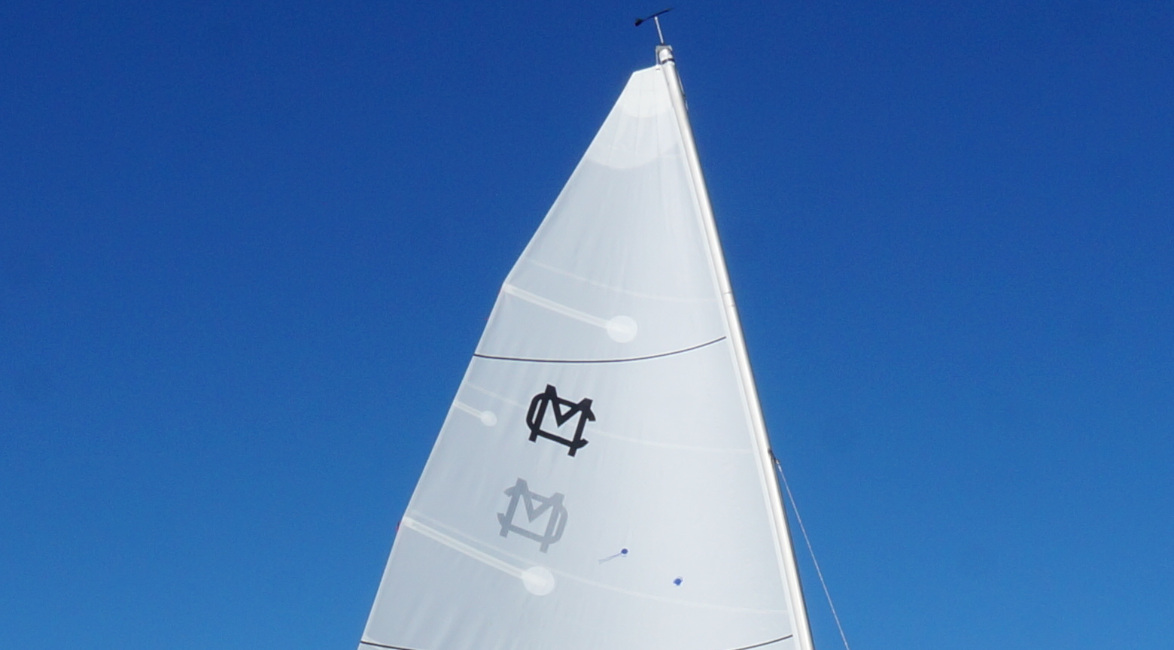As a follow-up to our series on Upwind Mainsail Trim, we wanted to sharpen our skills at analyzing upwind sail shape. With the help of a former sailmaker, we photographed sails and studied their “flying shape.” This post discusses what we learned.
We put draft stripes on the sails to show the shape and took photos from three locations: 1) a power boat directly behind, 2) a power boat directly abeam to windward, and 3) an on-board camera mounted below the boom. Each of these views gave us valuable information.
For this post, we’ll show photos of two sails made by our departed friend Will Hendershot, who made Two Mountain Sails. Will was a great sailor and freely shared his knowledge with others; we miss him.
Disclaimer: To allow us to compare the sails shown, we used the same boat and the same skipper for all photos. However, we were not able to ensure the same wind conditions. Also, slight variations in the view (camera location) can result in perceived shape differences.
Six Elements of Sail Shape
This post is a follow-up to our series on Upwind Mainsail Trim, which explains the individual concepts below in detail with graphics.
#1. Camber
Camber is the term for the depth, or fullness of a sail. A fuller sail provides more power, but also more drag. A flatter sail has less power and less drag, and thus better pointing.
The camber may be different in each part of the sail. Some sails have a gradual reduction in camber from bottom to top, while others have little or no variation.


#2. Camber Profile Along Chord Line
The draft stripes should have smooth curves, with no abrupt changes. Older sails or battens with too little tapering may show a “hinge” along the front of the batten pockets.

#3. Position and Profile of Maximum Draft
The location of the deepest part of the sail is called the position of maximum draft. In a cat-rigged boat, the maximum draft should be 40-50% back from the luff. This position should be consistent from the bottom to the top of the sail.

#4. Luff Fit to Mast
Sailmakers build depth into a sail with a luff curve and with broadseaming. The luff curve is designed to match the mast bend characteristics. Indicators of a poor fit include 1) extra fullness near the mast at one or more locations, 2) excessive overbend wrinkles in one area of the sail when trimmed hard.

#5. Entry Shape – Fine or Rounded
The entry shape of the sail determines pointing ability and the width of the groove. A sail with a fine (flat) entry will point higher but will be harder to keep in the groove. A rounder entry is good for light air and wavy conditions.

#6. Exit Shape – Leech
An open leech twists to leeward, which gives you speed but destroys pointing. A leech with “return” hooks to windward, which gives you pointing, but with more drag and therefore less speed.
Lower Leech
Ideally you want some return in the lower leech in all conditions to preserve pointing ability.

Upper Leech
You want the ability to manage the upper leech with mainsheet tension: open in puffs and flat or slightly hooked in to point.


Choosing a Sail
All the sails we looked at have proven to be fast, even though they have different design characteristics. Sail design involves tradeoffs since no sail will be perfect for all circumstances. Sailmakers can try to maximize a sail’s range across conditions, or they can target a specific wind range/crew weight. Sails with a wider range be more difficult to trim properly for the average sailor.
When choosing a sail, decide what’s important for you. In studying the sails for this post, we were looking for a sail with a wide range and the following characteristics:
- Fuller at the bottom, flatter near the top. This combination should maximize the sail’s range when sailing without a crew.
- Lower leech return. We wanted to preserve pointing ability when twisting off the upper leech to control angle of heel.
- Ability to manage upper leech without over-trimming or under-trimming. The sail controls are essential to shaping the leech, but we wanted the sail design to make it easier.
- In light air, we want the leech to remain somewhat open while trimming the mainsheet enough to have some mast bend.
- In breeze, we want the leech to open in puffs, but we also want to trim hard to maximize mast bend.
- Relatively fine entry in medium breeze. We prefer the pointing ability this gives. We liked sails that transitioned from a slightly rounder entry in light air to a finer entry in medium air.
Related Content
How to Photograph Sail Shape – Quantum Sails





